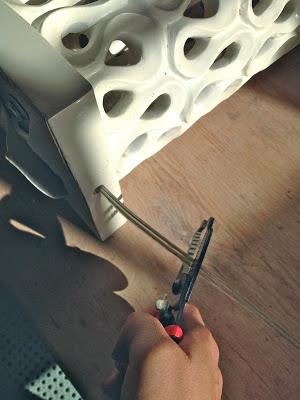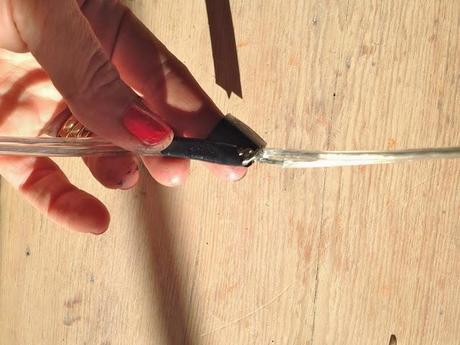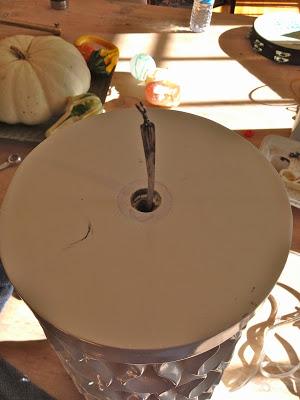Paint and new shades are the easy part, but almost all of these fixtures require new electrical wiring.
In honor of this obsession of mine I decided to make this week dedicated to lighting.
 Let's kick it off with a talk about rewiring.
Let's kick it off with a talk about rewiring.There are many levels here, but I say we take baby steps and start with a common lamp.
It can seem very daunting and scary. I remember the first time I rewired a lamp- I flinched as I turned the switch on fearing I did it wrong and was going to electrocute myself.
Obviously that didn't happen, and I slowly gained more confidence.
Once you understand the basics you will start seeing the possibilities
every time you pass an old discarded light fixture.
Now I like to pretty much rewire ALL old lamps for safety's sake.
Call me a Nervous Nellie, but you don't know why someone gave up
that lamp to begin with.
You don't know what lurks inside or how sound the connections are.
I just sleep better knowing the wiring is new and correct.
For this post I happened to have a newer lamp that was giving me trouble.
It would only turn on occasionally,
and I usually had to jiggle the switch to make that happen.
I figured there might be a loose wire (dangerous) so I decided to investigate.
Before we begin: ALWAYS MAKE SURE YOUR LAMP IS UNPLUGGED!
I started by pulling off the cardboard/metal sleeve that covers the socket.
 Usually all it takes is pinching the lower part near the switch and pulling upwards,
but mine wasn't cooperating. I had to use a screwdriver to pry it off, damaging the base.
But I did find the problem!
Usually all it takes is pinching the lower part near the switch and pulling upwards,
but mine wasn't cooperating. I had to use a screwdriver to pry it off, damaging the base.
But I did find the problem!
 Since this post is about "how to rewire" I was fine with the damage since I was planning on giving it all new guts (new socket and cord).
I headed over to my local True Value to gather my supplies...
Since this post is about "how to rewire" I was fine with the damage since I was planning on giving it all new guts (new socket and cord).
I headed over to my local True Value to gather my supplies...
 I went straight to the electrical department where they have everything you could ever want
and amazing customer service to boot.
I could seriously sing their praises all day.
If you get overwhelmed there is always someone experienced to help you figure out exactly what you need. I highly recommend bringing your light fixture with you if are at all confused.
I went straight to the electrical department where they have everything you could ever want
and amazing customer service to boot.
I could seriously sing their praises all day.
If you get overwhelmed there is always someone experienced to help you figure out exactly what you need. I highly recommend bringing your light fixture with you if are at all confused.
 My local store will even rewire fixtures for you! I have had them do a couple tricky chandeliers and lamps for me in the past, and they even replaced the cord on my vacuum.
My local store will even rewire fixtures for you! I have had them do a couple tricky chandeliers and lamps for me in the past, and they even replaced the cord on my vacuum.
I brought my old socket with me and I found a match...
 and I bought an 8' lamp cord set...
and I bought an 8' lamp cord set...
 I am a big fan of kits since they save time and a few steps, but
you can also buy the cord by the foot and attach a separate polarized plug if you wanted a
longer/shorter cord in a different color.
I am a big fan of kits since they save time and a few steps, but
you can also buy the cord by the foot and attach a separate polarized plug if you wanted a
longer/shorter cord in a different color.
Once you have your replacement parts you are ready to start.
You will need access to the base where the cord is fed into your lamp. Mine had a protective/decorative cover that I had to cut into:
 Next, using wire cutters I cut off the old cord/plug near the base.
Next, using wire cutters I cut off the old cord/plug near the base.
 If you are using a plug kit like I am you will have to feed the new cord in through the bottom.
If you are using cord by the foot with a separate plug
you have the option of feeding it through the top or bottom.
In many cases you can simply tape the new cord to where you just cut the old cord...
If you are using a plug kit like I am you will have to feed the new cord in through the bottom.
If you are using cord by the foot with a separate plug
you have the option of feeding it through the top or bottom.
In many cases you can simply tape the new cord to where you just cut the old cord...
 and pull the cord up from the bottom to the top.
and pull the cord up from the bottom to the top.
 My lamp was proving to be quite difficult on many fronts. Right before the wire got to the top it got stuck and broke off from the tape. I needed to remove the top neck/nipple to get it out.
My lamp was proving to be quite difficult on many fronts. Right before the wire got to the top it got stuck and broke off from the tape. I needed to remove the top neck/nipple to get it out.
 Once I did...
Once I did...
 it popped right through.
it popped right through.
 I threaded the cord through the nipple
and re-screwed that back into the lamp base.
I threaded the cord through the nipple
and re-screwed that back into the lamp base.
 Now it was time to wire the socket.
First loosen the side screw on the base of the socket...
Now it was time to wire the socket.
First loosen the side screw on the base of the socket...
 and attach it to the nipple by twisting it on and then tightening the side screw.
and attach it to the nipple by twisting it on and then tightening the side screw.
 Prepare your wire by snipping into the top to split it.
Prepare your wire by snipping into the top to split it.
 You want to pull it apart about 4-6 inches and separate the the two wires.
You want to pull it apart about 4-6 inches and separate the the two wires.
 Using wire strippers, strip off about an inch of the plastic protecting the wires.
To do so just center the wire in the proper size grove, clamp down and pull along the wire.
Using wire strippers, strip off about an inch of the plastic protecting the wires.
To do so just center the wire in the proper size grove, clamp down and pull along the wire.
 You should be left with abundant clean wire and no plastic.
If a lot of wire got cut off with the plastic, go up a size in the grooves.
If you still have plastic coating over the wire, go down a size.
You should be left with abundant clean wire and no plastic.
If a lot of wire got cut off with the plastic, go up a size in the grooves.
If you still have plastic coating over the wire, go down a size.
 Now you will need to tie an underwriter's knot with the wire.
The plug kit gives you an illustration of it on the backside, but basically you loop both wires and then have the opposite wire go through the other. This prevents the wires from getting pulled out of the socket if someone pulls the cord really hard.
Now you will need to tie an underwriter's knot with the wire.
The plug kit gives you an illustration of it on the backside, but basically you loop both wires and then have the opposite wire go through the other. This prevents the wires from getting pulled out of the socket if someone pulls the cord really hard.
 Before connecting the wires to the socket I like to mark the live wire with a Sharpie. Since they both look the same it can get confusing. This helps to eliminate the fear that you wired it wrong.
If you feel along the edge of you cord you will notice
one side has a smooth edge and the other is ribbed.
Smooth is your live wire side, ribbed is the neutral side.
Before connecting the wires to the socket I like to mark the live wire with a Sharpie. Since they both look the same it can get confusing. This helps to eliminate the fear that you wired it wrong.
If you feel along the edge of you cord you will notice
one side has a smooth edge and the other is ribbed.
Smooth is your live wire side, ribbed is the neutral side.
 Slide the sleeve off your socket...
Slide the sleeve off your socket...
 Take your live wire and twist it tightly together and then bend it like a candy cane.
Take your live wire and twist it tightly together and then bend it like a candy cane.
 THE LIVE WIRE GOES TO THE COPPER SCREW,
THE NEUTRAL WIRE GOES TO THE SILVER SCREW.
THE LIVE WIRE GOES TO THE COPPER SCREW,
THE NEUTRAL WIRE GOES TO THE SILVER SCREW.
 Loosen each screw and hook the wires behind.
Now tighten the screw until the wire is firmly attached. You want to squish it tight.
Loosen each screw and hook the wires behind.
Now tighten the screw until the wire is firmly attached. You want to squish it tight.
 Slide the sleeve back over the socket and press it firmly into the base until it is locked in place.
Slide the sleeve back over the socket and press it firmly into the base until it is locked in place.
 Give a gentle tug at the base if you have too much wire up on top.
Give a gentle tug at the base if you have too much wire up on top.
 Now for the true test.
You can now add a bulb, plug your lamp in and test it out.
Now for the true test.
You can now add a bulb, plug your lamp in and test it out.
 Success!
I finally have the pair working safely together!
Success!
I finally have the pair working safely together!

Stay tuned.
I have a 'Rewire 102' for hanging fixtures and tons of lighting inspiration coming up!
I was one of the bloggers selected by True Value to work on the DIY Squad. I have been compensated for my time commitment to the program as well as writing about my experience. I have also been compensated for the materials needed for my DIY project. However, my opinions are entirely my own and I have not been paid to publish positive comments.

